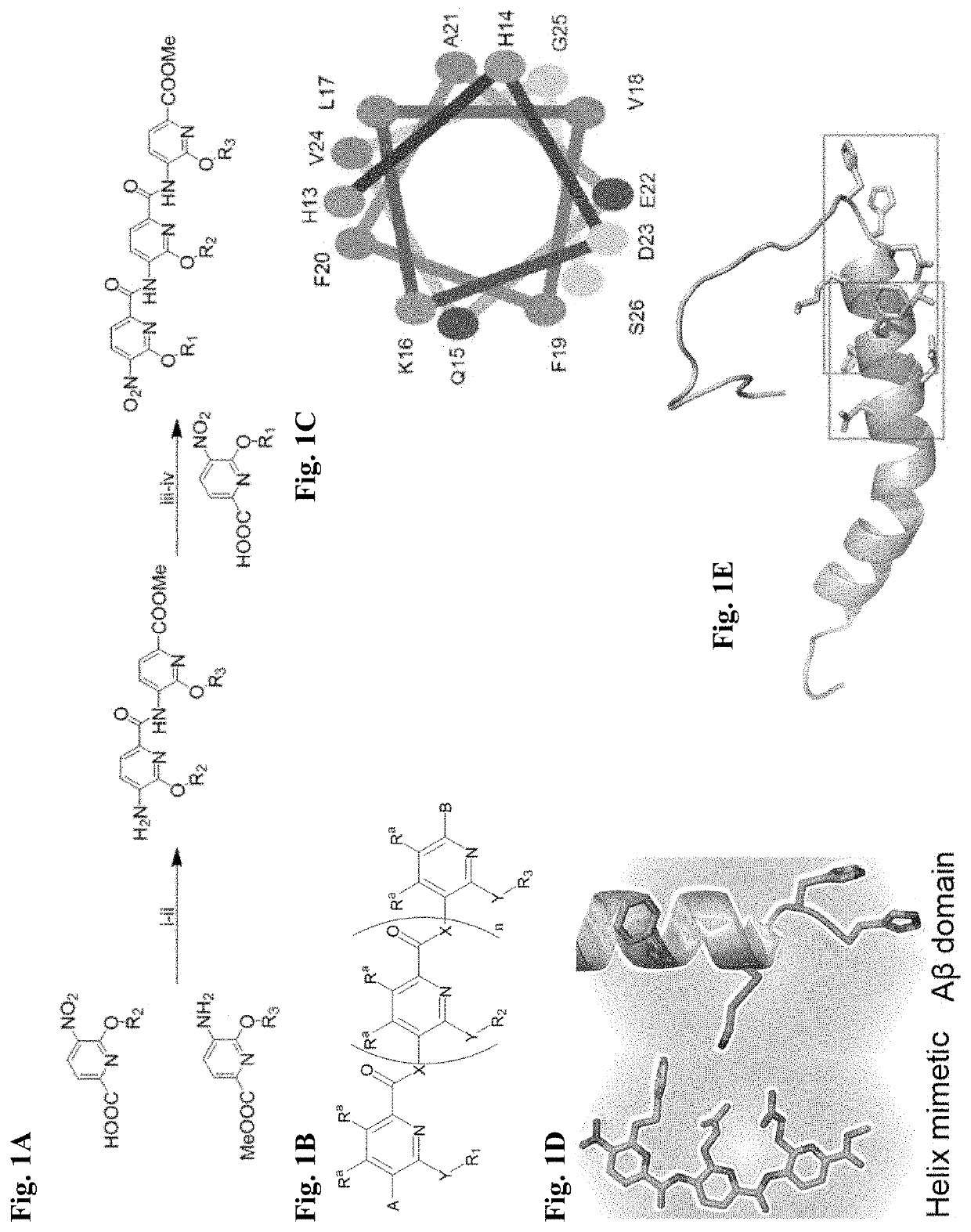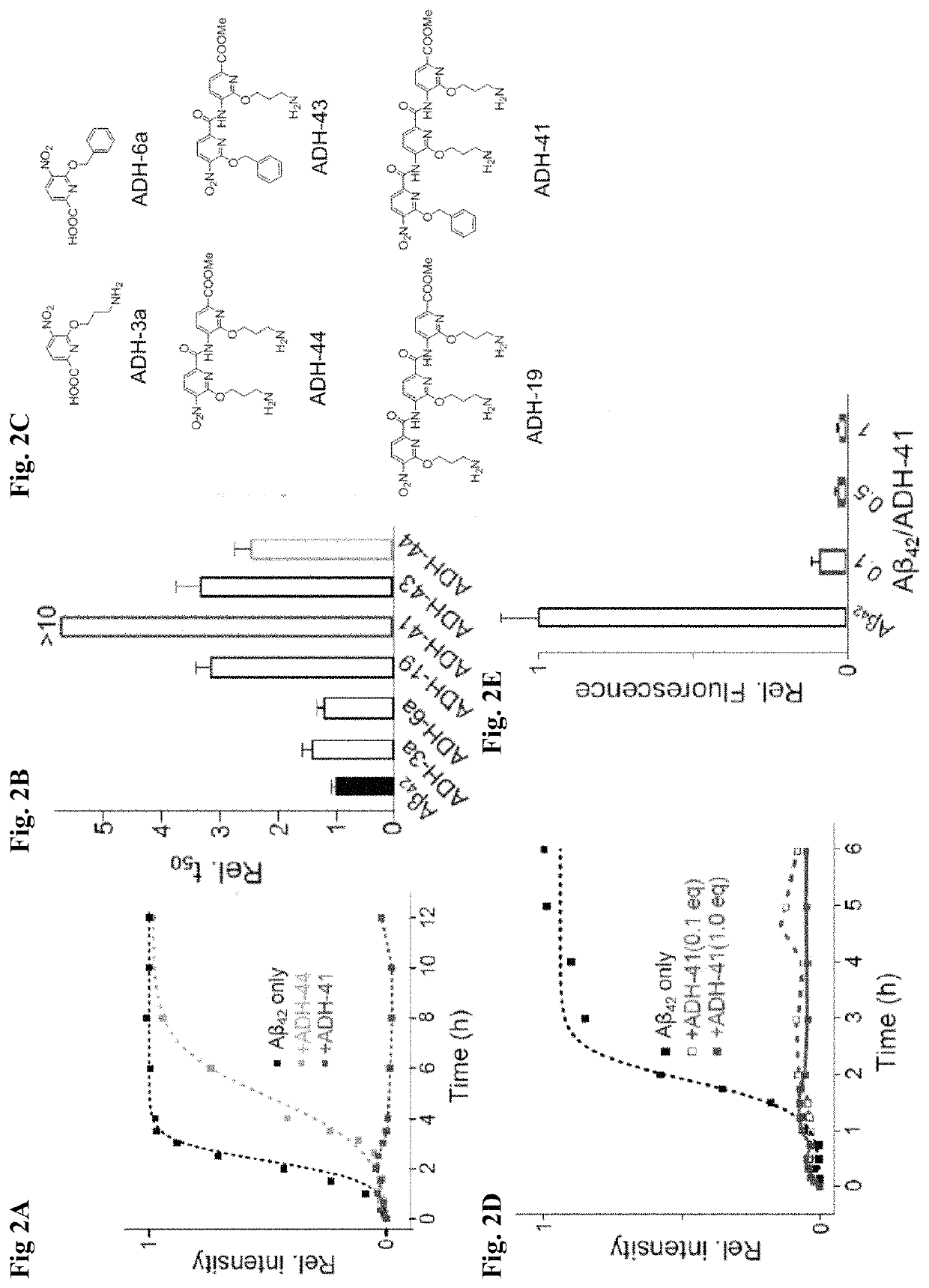Alpha-helix mimetics as modulators of Abeta self-assembly
a technology of alpha-helix mimetics and self-assembly, which is applied in the field of alpha-helix mimetics as modulators of abeta self-assembly, can solve the problems of difficult task, no cure or effective therapy for reducing unable to achieve the effect of reducing the burden or preventing the burden of amyloid in patients, reducing the burden, and reducing the burden burden
- Summary
- Abstract
- Description
- Claims
- Application Information
AI Technical Summary
Benefits of technology
Problems solved by technology
Method used
Image
Examples
example 1
Compound Synthesis and Characterization
[0425]A representative synthetic route for the synthesis of ADH-41 is provided in FIG. 16. ADH-41, a tripyridylamide of the invention, is synthesized from pyridyl precursors via a series of amide coupling reactions alternating with arylamide reduction reactions. The synthetic steps outlined in FIG. 16 are as follows: (a) tert-butyl (3-hydroxypropyl)carbamate, NaH (60% dispersion in mineral oil), toluene (anhydrous), 30 min. at 0° C. and then 4 h at r.t. (b) Tri-n-butyl(vinyl)tin, Pd(PPh3)4, toluene (anhydrous), 110° C., 12 h. (c) KMnO4, NaHCO3, Acetone, r.t., 6 h. (d) MeI, K2CO3, DMF (anhydrous), r.t., 4 h. (e) Pd / C, H2 (g), EtOAc, r.t., 4 h. (f) 2-chloro-1-methylpyridinium iodide, dichloromethane (anhydrous), Et3N (anhydrous), reflux, 5 h. (g) Pd / C, H2 (g), EtOAc, r.t., 10 h. (h) 2-chloro-1-methylpyridinium iodide, dichloromethane (anhydrous), Et3N (anhydrous), reflux, 5 h. (i) dichloromethane / trifluoroacetic acid / triethylsilane (80:15:5, v / v)...
example 1a
Synthesis of Helical-1
[0437]
[0438]A solution of 2,6-dichloro-3-nitropyridine (10 mmol, 1.91 gm) in toluene (50 mL, anhydrous) was equilibrated at 0° C. for 15 min. followed by the addition of tert-butyl (3-hydroxypropyl)carbamate (12 mmol, 2.1 gm, 1.2 eq.) at 0° C. under the atmosphere of argon. The reaction mixture was stirred at 0° C. for 15 min. after which NaH (60% dispersion in mineral oil, 0.52 gm, 13 mmol, 1.3 eq.) was added portionwise within a time span of 20 min. The reaction mixture was stirred for 30 min. at 0° C. and then at room temperature for 4 h. The completion of the reaction was confirmed by the disappearance of the starting material. The remaining NaH in the reaction mixture was quenched by careful addition of brine solution. The volatiles were removed using a rotary evaporator and the resulting mixture was partitioned between EtOAc and brine solution. The brine solution was extracted with EtOAc two more times. The organic layer was dried over Na2SO4, filtered, a...
example 1b
Synthesis of Helical-2
[0439]
[0440]To a solution of Helical-1 (1.66 gm, 5 mmol) in toluene (anhydrous, 30 mL), tri-n-butyl(vinyl)tin (1.9 mL, 6.5 mmol, 1.3 eq.) was added followed by the addition of Pd(PPh3)4 (117 mg, 2 mol %). The reaction mixture was stirred at 115° C. for 12 h under the atmosphere of argon. After 12 h thin layer chromatography confirmed the completion of the reaction. The reaction mixture was quenched by the addition of 1M KF (40 mL). The mixture was concentrated to ⅓ of the total volume and then partitioned between EtOAc and water (50 mL each). The aqueous layer was then extracted with EtOAc (2×50 mL). The organic portion was dried over Na2SO4, filtered, and concentrated. Column chromatography afforded the desired product as a pale yellow oil (1.34 gm, 83%). 1H NMR (600 MHz, Chloroform-d) δ 8.36-8.22 (d, J=8.1 Hz, 1H), 7.06-6.90 (d, J=8.1 Hz, 1H), 6.83-6.65 (dd, J=17.2, 10.5 Hz, 1H), 6.50-6.33 (d, J=17.2 Hz, 1H), 5.79-5.53 (d, J=10.6 Hz, 1H), 5.32-5.12 (m, 1H), 4...
PUM
 Login to View More
Login to View More Abstract
Description
Claims
Application Information
 Login to View More
Login to View More - R&D
- Intellectual Property
- Life Sciences
- Materials
- Tech Scout
- Unparalleled Data Quality
- Higher Quality Content
- 60% Fewer Hallucinations
Browse by: Latest US Patents, China's latest patents, Technical Efficacy Thesaurus, Application Domain, Technology Topic, Popular Technical Reports.
© 2025 PatSnap. All rights reserved.Legal|Privacy policy|Modern Slavery Act Transparency Statement|Sitemap|About US| Contact US: help@patsnap.com



